.jpg)
As part of the Appalachian Mountain chain, the Great Smoky Mountains and the Blue Ridge Mountains of Western North Carolina undoubtedly make it the best place to live to experience all four seasons. From the urban hub of Asheville to the ski resorts in the High Country and watersports in the Tennessee Valley, Western North Carolina has everything to offer.
Thanks to the mild climate and exquisite scenery everywhere you look, Western North Carolina is the best place to live experience all four seasons. Whether you want to lead an active lifestyle or simply relax and watch the scenery change throughout the year, Western North Carolina has it all. As well as having thriving commercial centers, the region offers an unrivaled view of some of the best landscapes in the world.
Weather in Western North Carolina
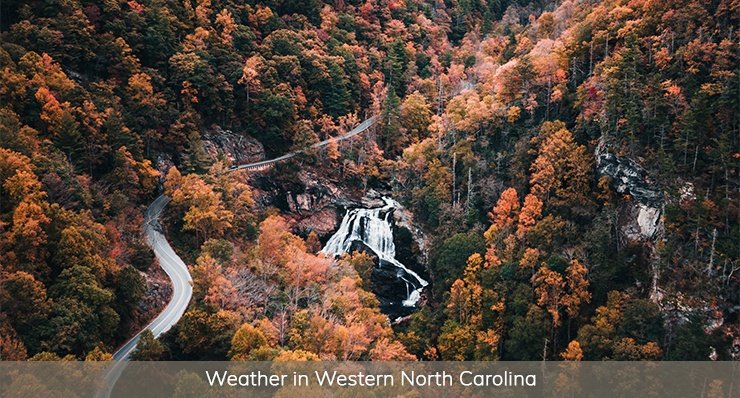
A humid subtropical climate occurs in much of Western North Carolina, although a subtropical highland climate is present at higher elevations. While the temperature can change considerably when you’re hiking or mountain climbing, Western North Carolina typically benefits from warm summers and relatively mild winters. As the best place to live to experience all four seasons, the weather in Western North Carolina simply enhances its natural beauty.
Falling within the Southeast Regional Climate Center, as defined by the National Centers for Environmental Information, Western North Carolina enjoys noticeable transitions from one season to another but avoids much of the extreme weather conditions that affect other parts of the country. Despite this, there are clear changes between each season. The warm and sunny summers are replaced by cool, crisp falls before the colder weather of winter sets in.
Extreme Weather in North Carolina
For anyone living in Western North Carolina or visiting the area, it’s important to know whether potentially extreme weather conditions are expected. North Carolina isn’t typically exposed to bouts of extreme weather.
The Great Appalachian Storm of 1950 may be one of the most famous natural disasters to hit the area, although there have been more recent periods of extreme weather. While storms have occurred in North Carolina at least every few years, the vast majority of weather conditions are relatively mild. Western North Carolina is not known for a high number of extreme weather events. According to the North Carolina State Climatology Office, a tropical cyclone makes landfall in North Carolina every four years. However, the majority of these cyclones affect the state’s east coast, as opposed to the western region.
Also, inland locations are less affected and often escape without any notable weather extremes at all. Western North Carolina, in particular, is afforded more protection due to its inland location.
What Are Summers Like in North Carolina?
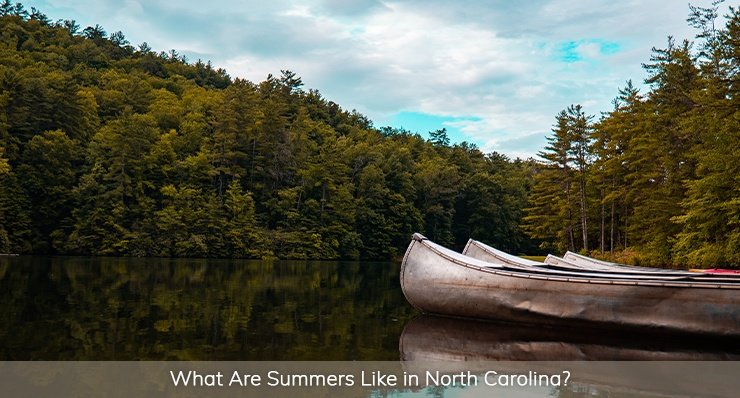
With beaches to the east and mountains to the west, summers in North Carolina offer everything you could possibly want and more. Whether you’re eager to relax and unwind or you want to set off on an unforgettable outdoor adventure, summer is the perfect time to do it in Western North Carolina. With numerous national parks, picturesque mountain ranges, deep woodlands, and mesmerizing forestry, you won’t have to travel far to find the ideal spot for a summer getaway.
With around 14 hours of daylight in Western North Carolina during the summer months, you’ll have plenty of time to explore everything the state has to offer. As temperatures drop in the mountains, you may want to use the summer to explore the ranges throughout Western North Carolina. There are hundreds of hiking trails to choose from and the warmer nights mean it’s a great time to extend your stay and pitch your tent at one of the many campsites in the area.
Of course, summer is also prime time for festivals and events in Western North Carolina. With a variety of extravaganzas taking place throughout the summer months, you can take part in as many as you want or sit back and watch the fun going on around you.
Summer in Western North Carolina is also the ultimate time of year to watch the sunrise or sunset. With some of the best views on earth, any visit to the region should incorporate a ‘sun-seeing’ expedition. Top places to watch the sunset in Western North Carolina include:
-
Blue Ridge Parkway
-
Biltmore
-
Max Patch
-
Mount Mitchell State Park
-
Gorges State Park
If you want to make the most of your summer in Western North Carolina, there’s plenty to keep you busy. The balmy temperatures mean outdoor adventures are top of the list.
With so much to see and do all summer long, it’s not surprising that people consider Western North Carolina to be the best place to live to experience all four seasons.
How Hot is North Carolina in the Summer?

Summer temperatures reach an average of 90 °F (32 °C) in July in North Carolina, so you can expect to enjoy warm days and slightly cooler evenings. However, the range of elevation in the state means that temperatures can vary quite dramatically. Indeed, the varying range of summer temperatures is one of the reasons Western North Carolina is such a popular location.
If you’re camping high in the mountains, for example, temperatures will be noticeably cooler than if you’re on lower ground. At Mount Mitchell in Pisgah National Forest, for example, the average summer temperature is around 68 °F (20 °C).
If you love the heat and want to enjoy the sun, there are plenty of places to explore at lower elevations. However, if you prefer cooler air and lower temperatures, simply choose one of the rental properties in the higher elevations of Western North Carolina and enjoy summer on your own terms.
With so many variations, you can practically choose your own temperature during the summer in Western North Carolina by simply changing your location!
For the majority of people, North Carolina has perfect summer temperatures. While averages of 90 °F (32 °C) certainly provide hot summers to enjoy, the heat rarely feels overbearing or too hot. With the option to enjoy lower temperatures at higher ground, the varied landscape of Western North Carolina means it’s the ideal place to live.
The endless natural attractions ensure summers are filled with camping trips, hiking, canoeing, white water rafting, and mountain biking, so you’ll have the opportunity to enjoy the warmth however you choose. Of course, if the heat does get to be too much, you’ll find it easy to cool off in the lakes, waterfalls, and springs which are dotted all over the region.
Is North Carolina Humid in the Summer?
North Carolina has a relative humidity level of 70.6%, making it the 23rd most humid state in the U.S.
While summer can be humid, this is not usually when the highest levels of humidity occur on the Plateau. In fact, the springtime is usually when the region is most humid and, as a result, fog and precipitation are most likely to occur in March, April or May. However, you may experience these conditions in summer months on the Plateau.
North Carolina is one of the most varied states in terms of landscapes and topography. This ensures that humidity levels don’t become oppressive or uncomfortable. With the opportunity to spend your time at higher elevations, it’s easy to escape the humidity. In Western North Carolina, in particular, the numerous peaks ensure it’s easy to enjoy lower temperatures and humidity levels.
While it can be humid in the summer in North Carolina, this doesn’t usually present a problem to the majority of the residents in the region. Indeed, summer does welcome higher temperatures and moderate humidity levels but the weather in Western North Carolina generally means that all seasons can be thoroughly enjoyed. Although the weather in some states can make it tricky to enjoy the heat of summer or the cold of winter, this isn’t an issue that generally applies in Western North Carolina.
What is Winter Like in North Carolina?
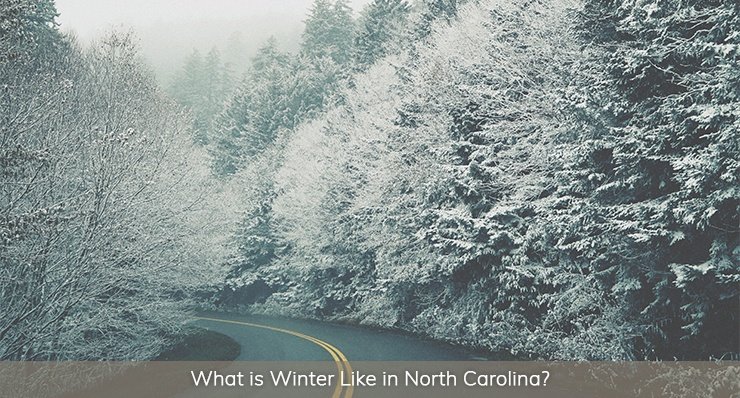
Unlike many areas of the U.S., North Carolina experiences relatively mild winters. The western part of the state, in particular, benefits from milder winters due to the positioning of the Appalachian mountain range. These high peaks act as a barrier against the cold winds from the north and west, thus affording extra comfort and protection to residents and visitors.
While areas outside of the mountain ranges can be hit by cold fronts from Canada, the western region of North Carolina is largely protected from these extremes. Like all states in the southeast, North Carolina’s winter temperatures remain relatively high due to the proximity of the Gulf Stream and the Atlantic Ocean.
In January, average temperatures in North Carolina are around 50 °F (10 °C). Dropping low enough to provide a real taste of winter yet mild enough to enjoy, the winter climate in NC is just one of the reasons it’s the best place to live to experience all four seasons.
Although typical winter temperatures in North Carolina are relatively mild, an arctic blast can affect the area from time to time. This usually occurs when cold air travels through the state to the east of the mountain ranges, as the protection offered by the mountains doesn’t extend to this region. As a result, the north-central and northeast of the state are generally affected.
Of course, winter temperatures do vary depending on your exact location within the state. In the mountains, for example, temperatures can drop quite considerably. In the Appalachian mountain range that extends into North Carolina, for example, the average temperature in February drops to 36.5°F (2.5°C) and is accompanied by an average rainfall of nearly 4 inches.
While it’s rare for the temperature to drop to below freezing point outside of the mountains, the lowest recorded temperature in North Carolina occurred in 1985 at Mount Mitchell. With temperatures dropping to −34 °F (−37 °C) at high elevations, it’s not surprising this season ended up in the state’s record books!
What is the Coldest Month in North Carolina?
Although winter stretches from December to February, January is the coldest month in North Carolina. Generally, this is when temperatures drop to their lowest and the New Year is welcomed in with snow coverings, chilly temperatures and shorter days.
Despite this, many people love the winters in North Carolina. Although the mild climate ensures that winter doesn’t become hazardous, the low temperatures still give you the opportunity to experience a ‘real’ winter.
Indeed, the vistas and landscapes of NC are, perhaps, at their best throughout the winter months. With snow building on the mountains and fog rising from the ground, the sites in the national parks and mountain ranges in winter are hard to beat.
How Much Snow Does Western North Carolina Get?
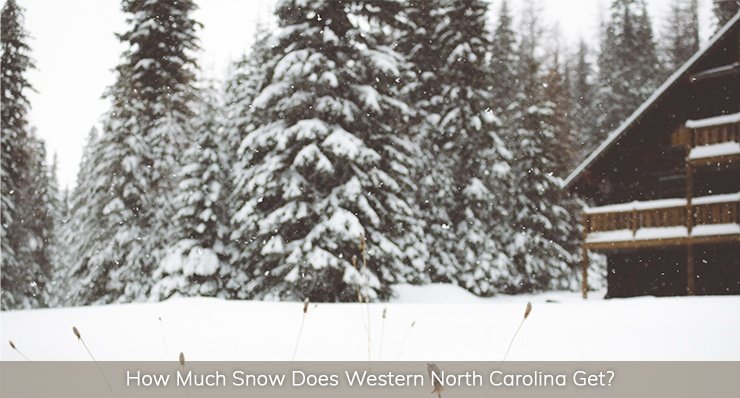
Snow is common in the mountains, particularly throughout fall and winter. Indeed, it would be highly unusual if it didn’t snow in these areas during the winter months.
On average, North Carolina as a whole receives around 5 inches of snow each year. However, this state average may not give a true representation of each area. Snow is more likely to fall in and around the mountains than on the coast, for example.
Western North Carolina receives a yearly average of 15.6 inches of snow throughout the year, with the majority falling during the winter months. Typically, it gets between 2 and 5 inches of snow during December, January, and February, with an average of 3 inches and less than 1 in March and April respectively. Also, you can expect to see an average snowfall of 0.7 inches in November.
For many people, the snowfall throughout North Carolina is the ideal amount. With protection from the mountains, most flurries in the west of the state are relatively light and do not usually stay on the ground for more than a day or two.
Even though more severe snowstorms have affected the state in the past, these are rare and do not represent the typical amount of snowfall in North Carolina. Indeed, many of the ski resorts in the state rely on snowmaking equipment to ensure there’s enough snow on the ground for residents and holiday visitors.
Typically, the amount of snow in North Carolina doesn’t have an impact on everyday activities but does provide a stunning backdrop. Whether you’re out hiking or enjoying the scenery next to a warming fire, the winter environment confirms Western North Carolina is the best place to live to experience all four seasons.
Fall in Western North Carolina
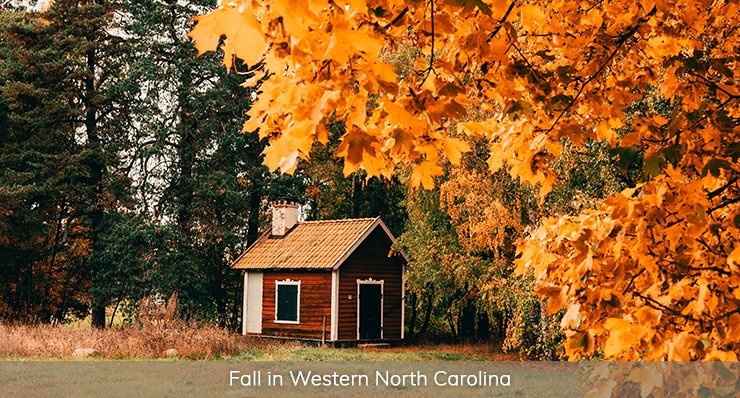
Fall is the favorite season for many residents of Western North Carolina and it’s easy to see why. As the leaves burst into rainbows of yellows, oranges, reds, and purples, the landscape is alive with color. Officially spanning three months – September, October, and November – fall offers a wonderful transition from summer to winter.
In Western North Carolina, the temperatures change most rapidly in Fall. The average temperature in September ranges from 76.9°F to 55.8°F, while average temperatures in November are between 55.8°F and 35.8°F.
As the summer weather begins to wane and just before winter sets in, the fall transition is the perfect time to enjoy the natural landscapes of Western North Carolina. Indeed, tourism tends to be at its highest during this season because of the stunning views and mild temperatures.
If you want to hike in the mountains or camp in the forests, fall showcases the scenery at its best. Exploring the outdoors in fall means you can avoid the harsher temperatures of winter or the heat of the summer.
What is the Best Time to See the Leaves Change in North Carolina?
Fall foliage is one of the finest sights to see and there’s no better place to witness the change than in North Carolina. Endless forests and woodlands create a stunning view of the foliage and fall is the perfect time to see them changing before your eyes.
The varying elevations in Western North Carolina ensure the changing leaves last as long as possible. This gives residents the opportunity to enjoy this spectacular natural phenomenon and extends the tourist season as visitors arrive in the state to enjoy the breathtaking views.
While the Blue Ridge Mountains are remarkable at any time of year, they are a particular highlight in fall. With one of the longest running ‘leaf seasons’ in the world, it’s the ideal place to enjoy fall in Western North Carolina and a top spot for ‘leaf peepers’.
Beginning in late September, you’ll see the leaves begin to change color anywhere the elevation exceeds around 4,000 feet. It’s in October, however, that the real changes begin to take place. In early October, the leaves begin to change at elevations above 5,000 feet and gradually get lower throughout the month. By the end of October, colors are changing as low as 2,000 to 3,000 feet. Places like Biltmore, Asheville and the French Broad River can be seen at their finest. By the start of November, fall foliage is changing color at elevations of just 1,000 to 2,000 feet, meaning it’s the ideal time for hiking or camping.
If you want to see the leaves change in North Carolina, October is the best month to visit. With prime spots all over the state, you can get a great view of the changing colors and fall foliage in the following areas:
-
Cashiers-Highlands Plateau
-
Blue Ridge Parkway
-
Mount Mitchell
-
Mount Pisgah
-
Whiteside Mountain
-
Great Smoky Mountains National Park
-
Forest Heritage Scenic Byway
-
Asheville
-
DuPont State Forest
-
Chimney Rock
-
Gorges State Park
Spring in Western North Carolina
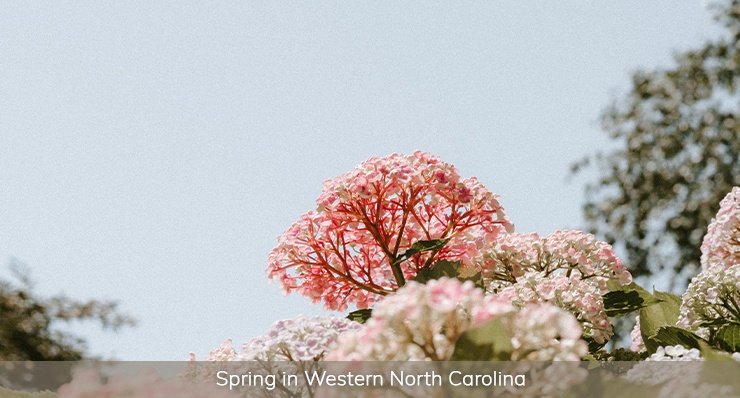
Spring in Western North Carolina is characterized by warm days and cool nights. May temperatures are usually the most varied, as the summer heat begins to arrive and winter makes its exit.
In Western North Carolina, average spring temperatures range from 37°F to 58°F in March, 45°F to 67°F in April and 53°F to 75°F in May. As the colder weather retreats, many residents enjoy getting back to the great outdoors and spend their spring walking national trails, exploring waterfalls and camping in the picturesque woodlands.
Tourists regularly visit Western North Carolina in the spring, too. Although these months can be humid, they are a breath of fresh air following the dark evenings and lower temperatures associated with winter. For residents, spring is typically known for warm days, stunning vistas, longer evenings and bursts of color as the flowers begin to bloom.
Wildflowers in North Carolina
Wildflowers are abundant in North Carolina and spring is usually the time to enjoy them at their best. With a varied and diverse selection of wildflowers growing throughout the state, and in Western North Carolina, in particular, it’s easy to see why it’s the best place to live to experience all four seasons.
Whether you’re a long-time resident or you’re visiting North Carolina in the spring, expect to see hundreds of varieties of wildflowers, including:
-
Swamp Rose
-
Birdfoot
-
Violet
-
Fire Pink
-
Wood Sorrell
-
Duckweed
-
Jack-in-the-pulpit
-
Pitcher plant
-
Dogwood
-
Rabbit tobacco
-
Cardinal flower
-
Carolina lily
-
Pinkshell azalea
-
Ox-eye daisy
-
Woolly mullein
-
Queen Anne’s lace
-
Chicory
Often considered to be one of the state’s most important natural resources, North Carolina’s wildflowers are an integral part of its past, present, and future. Once commonly used for medicinal purposes and as a food source, these beautiful blooms and resplendent shrubs are now studied by ecologists and botanists worldwide, as well as being admired by tens of thousands of people each year.
Where to Buy a Home in Western North Carolina
If you want to experience some of the best views in Western North Carolina, Lake Glenville could be the perfect location for your new home. With a selection of lakeview and lakefront properties, you can bask in the glow of this stunning body of water. Known for its pristine quality, Lake Glenville is ideal for swimming, boating and fishing, so why not take the plunge?
Sapphire Valley is another fantastic option if you want to enjoy the great outdoors in Western North Carolina. With a strong community spirit and endless activities to enjoy, Sapphire Valley offers year-round entertainment. From golf in the summer and skiing in the winter, to canoeing, kayaking and fishing all year round, this small town is the perfect place to enjoy NC at its finest.
Offering an exclusive private resort set within a 5,000-acre community, Lake Toxaway is an undeniably exquisite location. Homes boast panoramic views of the lake, mountain or golf course, while amenities include tennis courts, hiking trails, swimming pools and boating.
Franklin is becoming an increasingly popular residential location in the area, with people snapping up second-homes and vacation properties. Just an hour outside of Asheville and two hours away from Atlanta, Tennessee and Greenville, SC, you can combine the unparalleled beauty of the Western North Carolina landscapes with all the amenities you’d expect from this central location.
Highlands is the perfect spot if you want to relax near majestic waters, bike through the mountains or enjoy visits to local art centers and galleries. With a wide range of amenities and a stunning backdrop, Highlands in NC offers everything imaginable.
With their proximity to Asheville, Lake Glenville, Lake Toxaway, Cashiers, Highlands, and Sapphire Valley are all fantastic choices for your new home. Giving you the convenience of accessing citywide conveniences when you need them, yet offering you the seclusion, peace and privacy of the country, these Western North Carolina towns could be perfectly situated for your needs.
Find Your Home With Landmark Realty Group
If you want to move to the area or you’re planning an interstate relocation, Landmark Realty Group can help you find the home of your dreams. With extensive experience in the industry, our brokers are adept at finding the perfect homes for excited buyers. Whether you need a family home close to great schools and numerous amenities or you’re looking for a secluded hideaway, we’ll find the right property for you.
Our clients’ interests are at the heart of everything we do, so why not see for yourself? Bringing together experienced brokers from all over the Western North Carolina area, Landmark Realty Group offers unrivaled service.
While we offer real estate services and vacation rentals in NC, our expertise in the Western North Carolina region makes us the ideal choice when you’re looking for a property in the area. With extensive knowledge of the area, we can help you find out more about Western North Carolina and determine which town or city best fits your needs.
The stunning scenery in North Carolina is what attracts many homebuyers to the area. As well as finding you a spectacular home in the perfect location, we’ll also ensure you get the view of your dreams. If you’re looking for mountain views or a cottage surrounded by woods, we can help you get it.
Our tight-knit team is well-versed in the virtues of the region and can provide all the information you need if you’re thinking of moving to the area. What’s more – many of our brokers specialize in particular areas in Western North Carolina, so you’ll benefit from expert local knowledge when you talk to Landmark Realty Group.
If you want a home or vacation property in Western North Carolina, why not get in touch with us today? Regardless of what type of home you’re looking for, our agents will be on hand to scour our listings and find the perfect property for you.
To get started, contact us at (888) 743-0510 or email us at info@landmarkrg.com.
Posted by Landmark Concierge on
Leave A Comment